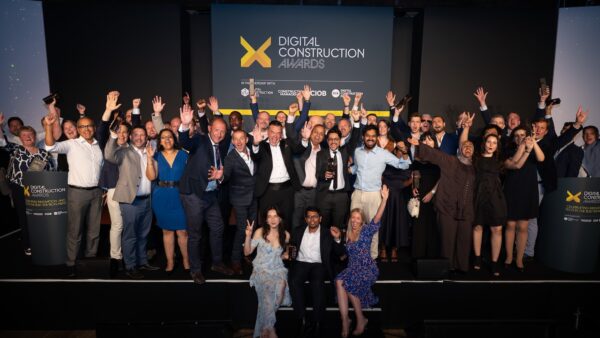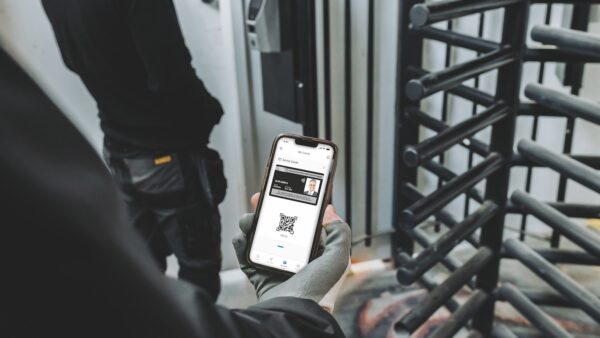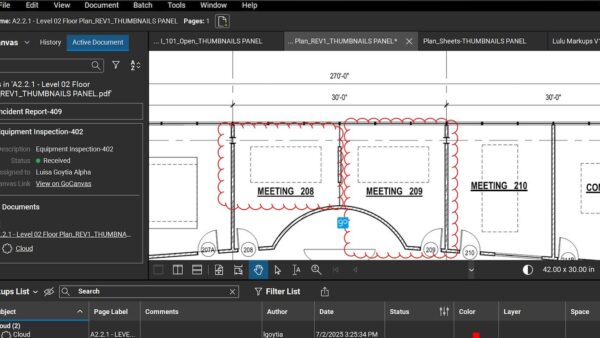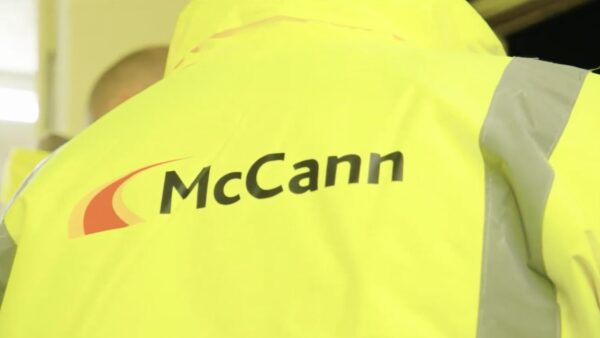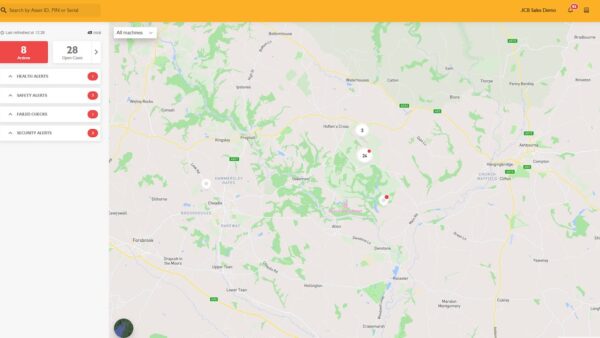Most projects that begin on a 19650/1192 route do not perform in line with the standards, creating significant problems and generating more costs and risk than many will realise, says John Ford.

Training consultants need to start providing more real-world advice, including the implications, and not just follow a perfect world situation for an industry that’s many years away from becoming business as usual.– John Ford
I have shared my experience from a number of projects in the illustration below, where I keep constant metrics for how many projects follow the standards and how many deviate. When they do deviate from industry standard, which is more often than not, I map how they deviate so I can fire control more effectively on future projects that follow the same path.
The illustration below shows the top three eventualities that occur on the majority of the client championed BIM projects that I have supported. The green process line is that as defined in PAS 1192-2/ISO 19650-2 that projects should follow if being compliant. This compliant process has happened on less than 5% of the assessed projects for a number of reasons.
The yellow process line forms more than 60% of the BIM-driven projects where clients don’t carry out the most important, fundamental step of reviewing their own information requirements to better understand what they need and when. Instead, they shortcut the process and appoint “BIM” consultants who more often than not will use their template documents, populate with a small amount of the client’s specifics and then issue that back to the project team.
This process is so extraordinarily wasteful as the requirements may be the opposite to what the client wants, goes far beyond their needs or indeed significantly deviates from the standards themselves, adding further acronyms and confusion. This results in the information that is issued to them being either of no use or unable to be consumed and so the effort made to collect it was at significant time, cost and resource of the supply chain.
The red process line happens on around 30% of BIM-driven projects. The client will either skip past the “BIM” consultant input or they use the consultant input, but do not include any requirements in the tender or appointment/contract.
In this scenario, where the client doesn’t issue specific requirements at tender stage, the supplier will then often propose their requirement templates (EIR templates) for insertion into the contract to satisfy their understanding of the standards. Unfortunately this results in the same issues of the yellow-lined scenario where the consultant’s stated requirements don’t truly reflect the client’s needs.
This is typical where everything has to be rushed for tender/contract signing purposes, and so this first and most fundamental step of 19650 is skipped. With the red process line, eventually the client realises that they are not getting what they thought, or in a format they need and so they claim they are being poorly treated.
In an effort to resolve the situation, further changes are made to the requirements very late on in the project. This often raises further frustrations as this happens half way through the design or later and in most circumstances results in rework of the design being required, including modelling and data input creating all kinds of waste from rework.
There are other eventualities that can occur on the final 5% of projects. I have assessed and catalogued four others in total and all add waste, complexity and results in an anti-BIM culture within the industry brought on by this lack of consistent delivery, which we simply cannot sustain long term.
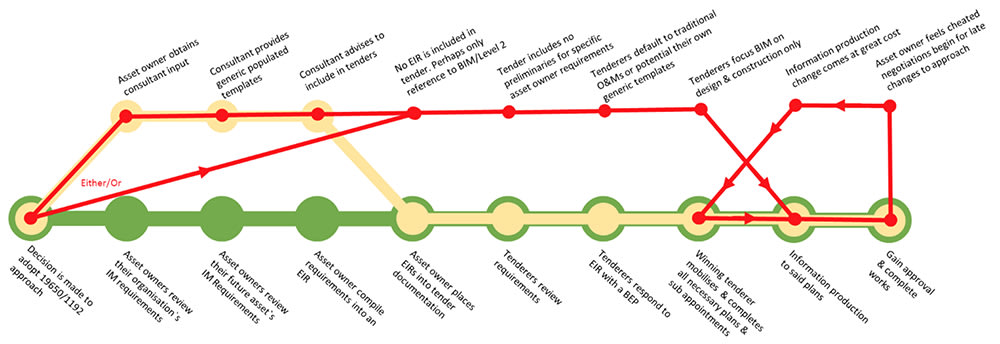
So what is the answer?
First, there needs to be better support and ownership of this issue for and by major clients, especially those in the public sector. We still have huge publicly funded asset delivery clients who are not following the fundamentals of 1192/19650 they chose to adopt and reference in tenders.
Some may argue that clients have an impressive suite of requirement documents, but as a contributor myself to many of the working groups, very little input came from the client/stakeholders themselves. Most of these requirements came from the working group consultants and supply chain.
I would recommend that neutral organisations like the BIM Alliance or perhaps key supply partners work together to audit or survey clients more directly and provide constructive feedback highlighting any deviation from the 1192/19650 standards as shown on the green process line. It is only when big organisations in this area get involved in the detail and put their weight behind improvement that things are likely to change.
There are many training consultants in the industry that give guidance on the implementation of BIM/information management within organisations and projects specifically in the form of 1192/19650. I have had a chance to review many of the training modules provided and almost all only train on the perfect scenario (the green process line). This is a problem if the training is aimed at any other audience than clients.
The reason I say this is, in my experience as shown above more than 60% of projects follow the faded yellow line (not establishing their own requirements) and 30% the red (don’t include any requirements at tender stage). So, when a main contractor or design practice takes this training based on the perfect 5-10% of situations, how quickly can they adapt to the 90% of time where the process is not being followed? From experience, I can tell you that it’s very difficult, especially when your client tells you half way through a project that they don’t want COBie, they want a Maximo sheet.
Training consultants need to start providing more real-world advice, including the implications, and not just follow a perfect world situation for an industry that’s many years away from becoming business as usual.
Businesses, adhering to ISO 9001 need to better prepare their staff for the non-perfect eventualities. Not just those related to BIM, but in many other aspects of the construction processes. I truly believe that the reason our industry is still far behind that of manufacturing in both collaboration, process and techniques is because of the many ways that a single simple task can or will be done.
Our industry and its approaches are not like dominoes with each piece falling exactly after its predecessor and just before the next subsequent piece like a “production line”. Our projects are forever putting ill-thought-out contingencies in place for sudden unforeseen issues because the business didn’t have a plan or solution, even though these “sudden, unforeseen issues” have happened many times on other projects. We don’t seem to be very good at responding to lessons learnt.
We also need to consider the following:
- If you don’t have an EIR or the EIR you have been provided with is not clear, or from your experience is either not a true reflection of your client’s needs or more complex than it needs to be, then challenge this far more than you are used to, stating in you tender response what you will and will not provide and offer sensible proposals for alternatives. This can then be worked out later before any contract is signed. Don’t just say “yes” in your proposals as I can tell you now, the costs can be high.
- Many EIRs that are provided at tender stage do not have a full set of appendices attached, with just a reference to other documents. Make sure you get these and raise queries. Many EIRs only contain the “HOW” and “WHEN”, but no “WHAT”. This is a problem as it tells you how to exchange information with them, but you have no idea what is wanted. How will you ensure that the “what” is not infinite, as is most often the case when your client’s expectations have not been managed?
- Challenge and support your internal business processes more to ensure that the right assessments are made early. If the processes don’t support any deviation, you personally could be taking risk that will impact the project. Challenge and provide feedback of your experience as part of lessons learnt and update procedures where necessary.
- Challenge your training providers more. Don’t take for granted that if you are told it will be sunny tomorrow on your long commute, that you don’t take an umbrella just in case, as experience tells us, it will unfortunately be raining most days. Ask for your trainers’ advice on how to deal with these matters and then work out if that advice does really work in tight tender situations or contract type.








